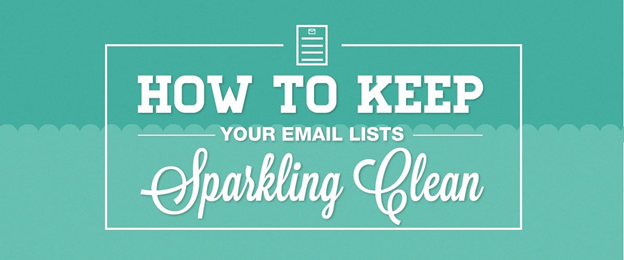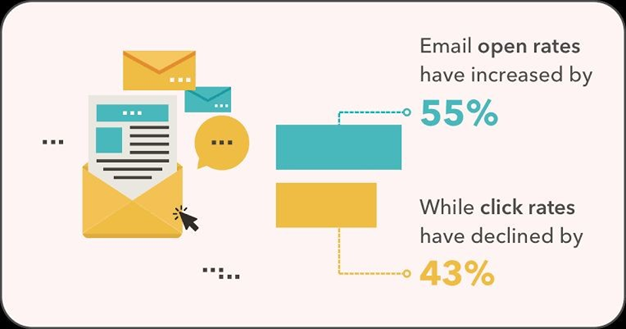How to Keep Your Email List Clean?
When is the last time you cleaned your email list?
If the answer is never, then you are possibly draining time, energy, and money on marketing to people who are not engaged in your business.
On average, email lists descend by around 22% every year. Up to one-third of your subscribers will not going to open your emails, much less click on your call to action. So, what is the purpose of communicating with them?
That is where email cleaning comes in.

What is Email Cleaning?
Email cleaning is excluding unwanted subscribers from your email list so that you can market only to people who want to get your emails.
This email list hygiene is an indispensable part of targeting your selling, so you should do email list cleanup at least a couple of times a year.
In this article, we will look at why email cleaning is vital, and give you a step by step guide to doing it.
Warning Signs:
The first place to look at is the bouncing rate and that is where we need to start and how many of them are currently active. There are two kinds of bounce rates to it. One of them is Hard Bounce Rate and the other one is a Soft Bounce Rate.
Soft Bounce Rate:
A soft bounce is an email address that they were briefly incapacitated to approach. It may be because their server was inoperative, or some other short-term problem. These addresses do not need to be excluded from your list right away but do remember that if the soft bounce continues week after week, it will become a hard bounce and then should be looked after.
Hard Bounce Rate:
Hard bounces are for email addresses that cannot be addressed forever. It might be because the email address has been stopped. Also, it may be something that you can resolve on your end, like a typo.
If the hard bounce is something you can fix, you should fix it and otherwise omit the name on your list! If the hard bounce is something you cannot control on your end, eliminate that email address from your list.
Open Rate and Click Rate:
Open rate and click rate are other things which are needed to be looked after. Take a look at what is been occurring over the last few email campaigns. If there is a model of waning open and click rates, you have got a problem.

Also, you may want to look at email marketing guidelines for your industry. While every list is unique if your open and click rates are too weak, then maybe you need to upgrade your email marketing works.
More Unsubscribes:
If we dig deep into this issue, It may also be the number of unsubscribes which led to the declining number of open rates and click rates.
Typos & Role Addresses:
A lot of typos in an email list can have an impact on the bounce rate. Some typos are visible and simple to catch for example, email addresses with gamil.com instead of gmail.com. Others require a bit more harvesting to clear. For example, you are not fundamentally going to know how a person's last name or company name should be spelt, but there are means to classify these issues.
Role addresses should also be deleted from your mailing list. These are emails that are support@ or info@. These are addresses that are easy to scan for and eliminate, and excluding them can have a positive effect on your standing with ISPs.
All of this adds up to one big red flag that people are not opening and clicking, they are not converting. It tells you that you are missing out on leads, sales and revenue.
Benefits of Email Scrubbing:
Email scrubbing can help turn that around. A few benefits of email scrubbing are given below:
Better Open and Click Rates
Open and click rates are determined as a percentage of the total number of emails sent.
Cleansing your email list means you are sending emails only to those who are excited. Even if the same people as before are opening your emails, they will now be a greater percentage of the total emails sent. And that grows your open and click rate percentages.
But if the same people are opening and clicking your emails, why does that percentage matter?
Here are a few good reasons
Fewer Spam Complaints:
Cleansing your email list also diminishes the number of spam complaints. A few subscribers list your emails as spam, even if they actually signed up.
The intricacy is that mailbox providers like Gmail, Yahoo, and others log spam accusations. If there are abundant, they will begin sending your emails straight to the spam folder, avoiding the inbox.
And they will do that for everyone you send email to, not only the people that reported you. Again, that drastically destroys the opportunity to get conversions, leads and sales from your email list.
This is an enormous obstacle for all email marketers. In all fairness, the number of victoriously delivered emails is on the slump globally.
Email scrubbing benefits by reducing the number of subscribers who are outraged enough to mark your emails as spam. Fewer spam complaints represent better sender fame. That means most of your emails will end at subscribers inboxes.
Fewer Bounces:
Undelivered emails remain to cause a lot of trouble for email marketers, as the bounce codes are mysterious and lack regularity across different email clients. Nevertheless, this is a cynical step in list administration, and honestly, it enhances your email ROI by not sending to addresses that bounce. You do not have to read every bounce code, you just have to control hard and soft bounces.
A soft bounce is a short deliverability enigma, such as a full inbox or a server that is malfunctioning. It is okay to resend emails to these addresses because there is a good possibility they will go through on the second or third attempt.
A hard bounce is a perpetual deliverability difficulty, such as an invalid email address. Since there is no possibility the email will ever be delivered, it is important to remove these addresses instantly.
ISPs track the number of bounces you produce with each send and use it when defining your prominence. If you create several bounces, internet service providers (ISPs) may block your messages. Keeping these addresses on your list will also skew your analytics in a negative fashion.
Decreased Cost:
Email marketing assistance often charges corresponding to the number of emails you send or the number of subscribers you have, or both.
That means there is a substantial economic incentive to keep your email list clean. Every detached subscriber who stays on your list is costing you money.
Practice email scrubbing to eliminate them and you can develop email marketing ROI.
Better Reporting:
There is one ultimate advantage of email scrubbing.
If your email list is bloated with uninvolved subscribers, it can be laborious to tell how your email marketing policy is operating. Subscriber inactivity and spam charges will skew your stats.
But if you have a shorter list that is absolutely involved in and working on your information, your email marketing statistics will be more precise. This means you can reliably use that information to manage your future marketing endeavours.
Which Email lists should you Scrub?
One question people inquire about email cleaning is which email lists they should clean. Here are a couple of tips:
Begin with the usual active email lists because those are the ones pushing conversions, leads and sales.
Pay consideration to older lists, too, because unengaged subscribers who are on the list may yet count as part of the total.
Even if your email list is comparatively new, there is no point in emailing people who are not involved.
That is why the short answer to which email lists to scrub is: all lists. If you are marketing frequently, you should also clean your list periodically, at least a couple of times a year.
Send Regular Emails:
Once you have a record of email addresses you know are genuine, from people who are eager to be there, it is up to you to stay in constant communication!
Establishing a routine schedule for your emails holds your fans interested and open rates flying. People who truly want to be on your list will be delighted to see your content and updates on a regular basis. If you only send emails hardly ever, it is likely that even those who want your business will ignore it or question why they are on your email list.
Forwarding routine emails is also an exceptional way to weed out people who do not genuinely want to be there. When a client or candidate frequently receives an email from a company they are not thrilled to hear about, it is more probable to force them to unsubscribe. Someone leaving your list may look like a distressing thing, but it actually protects you from having to do the job of distinguishing them as uninterested subscribers and excluding them on your end.
Conclusion
Technodatagroup would give that further information as to how email cleaning is able to optimize your list and how it benefits the company. In addition to the benefits for companies listed above, the reader also wins.
In short, email marketing is an exceptional tool to market our product and also to better our conversion, sales, and revenue.

